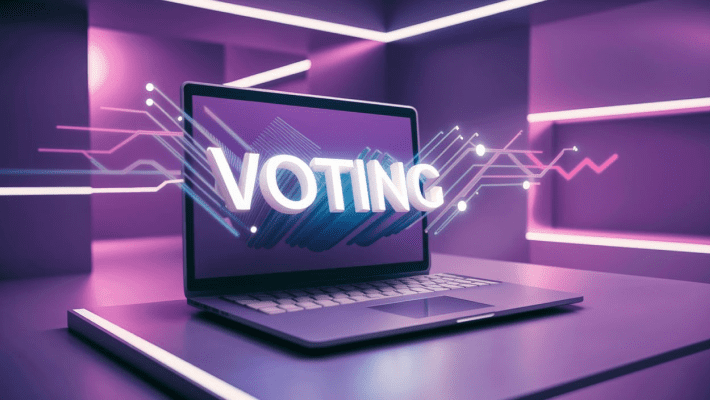Busting Myths About Blockchain Voting
03 May 2024In the ever-evolving digital technology landscape, few innovations have sparked as much debate and speculation as blockchain. Initially popularized as the foundation of cryptocurrencies development like Bitcoin, blockchain has since captured the imagination of enthusiasts across various industries, promising a decentralized and secure solution to age-old problems.
One such area where blockchain's potential has been touted is in voting systems, offering the prospect of revolutionizing democratic processes worldwide. However, as with any new technology, the reality of blockchain voting may not match the utopian visions painted by its proponents.
In this guide, we aim to delve deep into the heart of blockchain voting, separating facts from fiction and uncovering the truth behind the hype.
Understanding Blockchain Voting
Blockchain voting relies on blockchain technology development. The blockchain technology is a decentralized ledger system where transactions are recorded across a network of computers. This system ensures transparency and tamper-evident records.
However, it's vital to understand that while blockchain offers promising features like immutability and security, it's not foolproof. According to a recent study, blockchain-based voting systems face security vulnerabilities and potential privacy concerns.
Grasping these fundamentals is essential for assessing the true implications of blockchain in voting processes.
Myth: Blockchain Voting is Perfectly Secure
A widely held misconception about blockchain voting is that it provides ironclad security. Advocates claim that the cryptographic methods used in blockchain technology make it nearly impossible for anyone to hack or manipulate the system. However, the truth is more complex.
Although blockchain can improve some security aspects, it's not foolproof. Studies and real-world examples reveal vulnerabilities that could compromise the integrity of blockchain-based voting systems.
According to a recent study by MIT researchers, vulnerabilities in blockchain voting systems could expose them to manipulation and tampering. Despite cryptographic safeguards, the study found that attackers could exploit weaknesses in the software or infrastructure supporting these systems, undermining their security.
This underscores the importance of critically evaluating the security claims surrounding blockchain voting. Implementing robust security measures, such as encryption protocols, multi-factor authentication, regular security audits, and the utilization of smart contracts, is essential to fortify the resilience of blockchain voting systems against emerging threats and vulnerabilities.
Myth: Blockchain Voting is Completely Transparent
Another common misconception is that blockchain voting guarantees unparalleled transparency, enabling voters to verify the integrity of election results easily. While blockchain does provide a degree of transparency by making all transactions publicly accessible, it does not necessarily ensure full transparency in the context of voting.
Many believe blockchain voting ensures complete transparency, allowing voters to confirm election results easily. While blockchain offers some transparency by making transactions public, it doesn't guarantee full transparency in voting.
Problems like pseudonymity and coercion make achieving real transparency challenging. As such, while blockchain may improve certain aspects of transparency, it's essential to recognize its limitations and address concerns to build trust in electoral processes.
Myth: Blockchain Voting Eliminates Fraud
The belief that blockchain voting eradicates all electoral fraud is widespread among its supporters. However, recent studies indicate that while blockchain can help reduce certain types of fraud, like double voting, it doesn't eliminate all risks.
It introduces new challenges, such as identity manipulation or digital coercion. According to a US Vote Foundation report, blockchain-based voting systems can still be vulnerable to manipulation, raising concerns about the integrity of election outcomes.
While blockchain offers some security benefits, it's not a foolproof solution for preventing election fraud. Vigilance and additional safeguards are necessary to address the evolving landscape of electoral integrity.
Myth: Blockchain Voting is Accessible to Everyone
The idea that blockchain voting is accessible to everyone is often promoted by its advocates. They claim it allows people to vote securely from anywhere, thus improving accessibility. However, the truth is more nuanced.
While blockchain technology can offer remote voting options, it also brings new challenges. For instance, not everyone has the digital skills to navigate blockchain systems, creating a barrier for some voters.
Moreover, marginalized communities may face additional challenges accessing and understanding blockchain-based voting platforms.
To truly make voting accessible to all, we must address these digital literacy gaps and ensure that no one is left behind in the transition to blockchain-based electoral processes.
Evaluating the Pros and Cons
Now that we've clarified some common misconceptions, let's explore the advantages and disadvantages of blockchain voting:
Pros
-
Increased Transparency: Blockchain technology can make the voting process more transparent by recording all transactions publicly.
-
Enhanced Security: The cryptographic features of blockchain can help protect against tampering and fraud.
-
Auditability: Blockchain's immutable ledger allows for easier auditing of election results, potentially improving confidence in the integrity of the process.
-
Potential for Remote Voting: Blockchain may enable secure remote voting, expanding access to the electoral process for those unable to vote in person.
Cons
-
Complexity: Implementing blockchain voting systems can be technically challenging and require significant expertise.
-
Privacy Concerns: While blockchain provides transparency, it also raises privacy concerns as all transactions are publicly visible.
-
Digital Divide: Not everyone has access to the technology or the digital literacy required to use blockchain voting systems, potentially excluding certain demographics.
-
Security Risks: Despite its security features, blockchain is not immune to attacks, and malicious actors may exploit vulnerabilities.
We must recognize that blockchain voting is not a one-size-fits-all solution as we weigh these pros and cons. The decision to adopt blockchain technology in electoral processes must consider its potential benefits, limitations, and risks. A thoughtful and informed approach is essential in shaping the future of democracy.
Best Practices for Implementing Blockchain Voting
Implementing blockchain voting systems requires careful planning and consideration. Here are some key best practices for policymakers and election officials:
Prioritize Security: Implement robust security measures to protect against cyber threats and ensure the integrity of the voting process. This includes encryption protocols, multi-factor authentication, and regular security audits. Smart contracts, a core feature of blockchain technology, can help automate and enforce security measures, enhancing the overall resilience of the voting system.
Ensure Transparency: Foster transparency by providing clear information about how blockchain voting works and how votes are recorded and counted. This helps build trust among voters and stakeholders.
Address Accessibility: Take steps to ensure blockchain voting systems are accessible to all voters, including those with disabilities or limited access to technology. Provide alternative voting methods for those unable to use blockchain platforms.
Promote Education: Educate voters about blockchain technology and its use in voting. Provide resources and training to help voters understand how to use blockchain voting systems effectively.
Collaborate with Experts: Work with cybersecurity experts, technologists, and other stakeholders to effectively design and implement blockchain voting systems. Collaboration ensures that systems are designed with security and usability in mind. What can you do with a cybersecurity degree? This expertise is invaluable in ensuring the integrity and security of blockchain voting systems.
Pilot Programs: Consider conducting pilot programs or small-scale trials of blockchain voting systems before full-scale implementation. This allows testing and refinement of the technology in a controlled environment.
Evaluate and Iterate: Continuously evaluate the effectiveness of blockchain voting systems and be prepared to make adjustments as needed. Solicit feedback from voters and stakeholders to identify areas for improvement.
The Road Ahead: Navigating the Evolution of Blockchain Voting
The future of blockchain voting is full of possibilities, but it also presents challenges. Here's what to consider as we move forward:
Technological Advancements: Keep an eye on advancements in blockchain technology. New developments could improve voting systems' security, efficiency, and usability.
Research and Experimentation: Support ongoing research and experimentation with blockchain voting. By testing new ideas and approaches, we can learn what works and what doesn't, paving the way for innovation.
Caution and Evidence-Based Decision-Making: Approach the evolution of blockchain voting with caution. Base decisions on evidence and data, rather than hype or speculation, to ensure that changes are beneficial and effective.
Commitment to Democracy: Stay committed to upholding the principles of democracy. Blockchain voting should prioritize fairness, transparency, and accessibility for all voters.
Collaboration and Dialogue: Foster collaboration and dialogue among stakeholders. By working together, we can address challenges and find solutions that meet the needs of everyone involved.
Conclusion
In conclusion, the debate surrounding blockchain voting is far from settled. While it offers intriguing possibilities for enhancing the integrity and accessibility of electoral processes, it is not without its pitfalls.
By critically examining the prevailing myths and unveiling the truth about blockchain voting, we can foster informed discourse and pave the way for a more transparent, secure, and inclusive democratic future.
As we navigate this complex landscape, let us remain vigilant in our pursuit of truth and wary of illusions masquerading as revolutions.
We ❤️ Development
Follow us on social media to receive the hottest blockchain development updates










